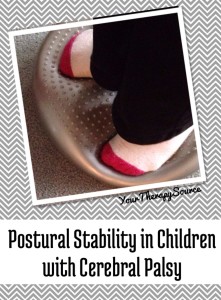Postural Stability and Cerebral Palsy
Pediatric Physical Therapy published research comparing postural stability during static upright standing between 45 children with cerebral palsy (CP) and 45 age-matched peers with typical development (TD) ages 5-12 years old. A posturography device was used for assessment. Postural stability was evaluated under 4 sensory conditions: eyes open and eyes closed on a firm surface; eyes open and eyes closed on a foam surface.
The results indicated the following:
1. Statistically significant differences were obtained between children with spastic diplegic CP and children with TD under all conditions involving visual and somatosensory conflicts
2. no significant differences were found between children with hemiplegic CP and children with TD.
The researchers concluded that children with spastic diplegic CP have increased postural instability under sensory conditions with both visual and somatosensory conflicts.
Reference: Saxena, Shikha MPT; Rao, Bhamini K. MPT, PhD; Kumaran, Senthil MPT. Analysis of Postural Stability in Children With Cerebral Palsy and Children With Typical Development: An Observational Study. Pediatric Physical Therapy Fall 2014 Vol. 26 – Issue 3: p 325-330
[subscribe2]



